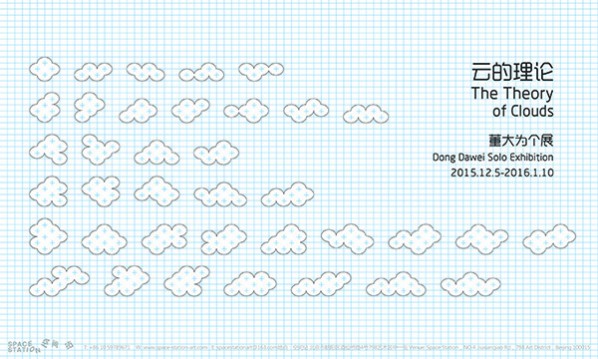
“The Theory of Clouds” presents several series of works, in which Dong Dawei attempts to build a comprehensive system, that showcases the finest work within the artist’s deep cognition. The works reflect diversity, an ecological chain within the material world, functioning as a complete organism.
Usually, most people classify Dong Dawei’s drawings based on his use of point, line, surface, color, composition and other purely fundamental painting language to express one’s inner feelings, thus abandoning figurative subject matter and narrative. In response to this, Dong Dawei says that actually every one of his works employs figurative motifs, even to the extent that they often appear to be figurative at the same time. The artist hopes that this kind of drawing may serve as a response to these false concepts which dictate that: abstract artists do not have a definite subject matter, content, or common figural experience and thus do not resonate with people. Although they have varied appearances and vast surface possibilities, fundamental research comes from the composition of a simple form, in which the process of its most basic make-up generates tension. In the early stages of preparing for this exhibition, even before beginning any of the paintings, Dong Dawei created a strict plan for completing the works. He was very clear about which series he would embark upon, in addition to which materials he would employ. The purpose of all of this was his desire to present a “complete exhibition” rather than merely staging an exhibition.
While writing the novel “The Castle of Crossed Destinies,” writer Italo Calvino built upon the narrative structure of the book by choosing Tarot cards. Dong Dawei was inspired by this, and regards each of his works as a Tarot card, attempting to allow each of the works different dots and structure. There are associated motifs, analogous to Calvino’s story of a maiden clasping a bunch of flowers who comes across a saber yielding warrior within the forest. His present 8 series include “Waves,” “Ripples,” “Snake,” “Volcano,” “Fault,” “Rose,” “Planets,” and “Cloud Theory.”
It is assumed that they have a definite associated narrative function: For example the viewer may imagine waves of water, but then suddenly, the water separates. A snake swims across the surface of the water before all is calm again as the sparkling waves create small ripples; Or perhaps, when looking at the volcanoes and faults, a volcano suddenly erupts due to an underground geological earthquake. The fault series has the greatest narrative function, where two parts become three, three parts become four, implicating the continued developing strength of the earthquake. Dong Dawei insists that each of his works conform to the same measurements, much like a collection of Tarot cards. To do this, he must overcome several obstacles. Because of technical reasons, His series are not able to be large in size. However, the artist does not give up because of these limitations, rather he continues to make adjustments to the entire project.
Within the realm of figurative painting, clouds are an “exception.” They are the only image in which there is no way to represent using perspective. But within the fractal theory of mathematics, anything, including the most complex forms found within the natural world may be obtained through the process of fractal repetition of their most fundamental elements. In this context, clouds are no longer an exception. Dong Dawei’s work brings to fruition the combination of fundamental elemental structures. This method not only constitutes abstract diagrams, but also expresses figurative objects. Conversely, from behind “every work’s appearance,” each has it’s own unique structural form. This mode of logical thinking is similar to mathematics and geometry, where simple and effective formulas or models are used to express particular rules and structures.
While Dong Dawei’s painting theory is based on mathematical thinking, his works are vehicles of substance. The employment of specific materials, experiences and methods for which the artist makes marks on the paper, in addition to the design of special physical phenomena are crucial to the work’s successful completion. This transformative process requires thousands of experiments. After calculating logic, performing trial and error experiments, and hiding integrated designs within a transparent surface, the portions in which we see are analogous to when a scientist has proved a complex theory, finally giving us a formulaic or principle model of interpretation. Therefore, with respect to usual abstract art, Dong Dawei’s work is organic and experimental. The works are similar to fractal geometry, derived from the fractal information, design, and artistic visual applications. “The Theory of Clouds” is a cognitive model of the natural sciences. Finally, Dong Dawei as also created a series called “Cloud Theory.” However, the most fundamental points which form the clouds do not entirely conform to a strict scientific structure, revealing that the artist cannot entirely hide the work’s poetic and emotional qualities.
Text/Guo Fang
About the exhibition
Date: 2015.12.05–2016.01.10
Venue: Space Station
Courtesy of the artist and Space Station.




























